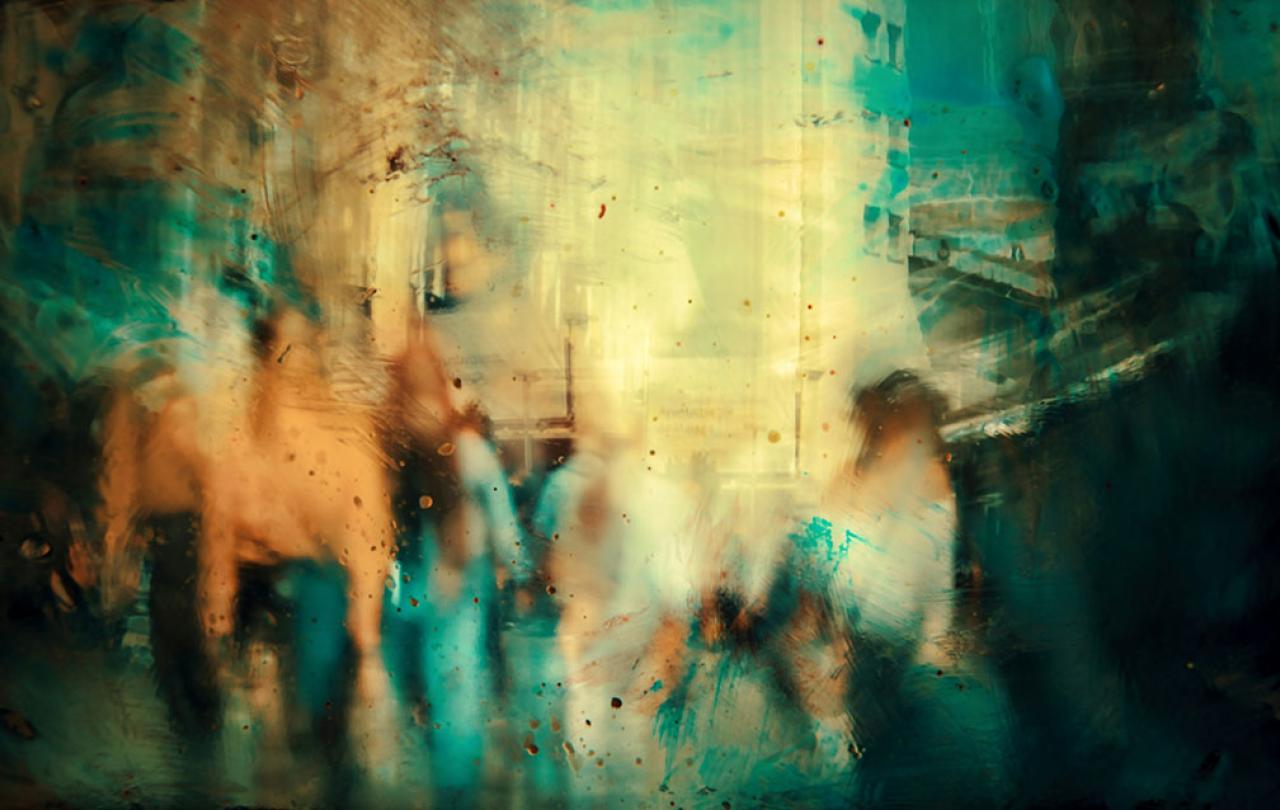The rise of Islam
In the 7th century, Christian Byzantine rule over Jerusalem came to an end. The new faith preached by Muhammad (570-632) inspired determined armies to spread northwards from the Arabian desert. The second Caliph, Omar, accepted the surrender of Jerusalem bringing it under Arab, Muslim rule for the first time, although people of Arab descent had been in the land for a long time before – they are mentioned in the New Testament in the second chapter of the Book of Acts.
Since the Roman destruction of the temple in AD70, during the Byzantine period the site of the old Jewish temple had been kept as a dump for rubbish. In around 690, a Muslim ruler, Abd-al-Malik built the Dome of the Rock as a shrine on the site, to mark Muhammad’s reported night journey to heaven, followed soon by the Al Aqsa mosque nearby on the same site. Jerusalem now became a site of Muslim Pilgrimage.
In the early 11th century, tensions between Muslims and Christians led Caliph Hakim to demolish much of the Church of the Holy Sepulchre, which was rebuilt shortly afterwards, but in a much less impressive format. In 1099 western Christians, hearing of attacks by Muslims on their holy places, and inspired by the idea of re-taking the Holy Land for Christendom, arrived in Jerusalem as part of the First Crusade. The Second Crusade arrived sometime later, but the Crusader armies were finally beaten by the Muslim leader Salah-ud-din (Saladin) in the battle of Hattin in Galilee in 1187. A third crusade tried to win the land back but was unsuccessful and the last Crusaders were banished back to Europe in 1291.
From the 13th to the 16th century, the land was ruled by the Mamluks, an Egyptian military class of former slaves. Meanwhile, the Byzantine empire came to an end in the mid-C15th when Constantinople fell to the Ottomans, or Turks. This was the beginning of the Ottoman Empire, which ruled over the land of Palestine for 400 years, from 1517 to 1917. In the C16th the Ottoman emperor Suleiman the Magnificent built the famous walls of Jerusalem that are still standing today.
Throughout this long period, most inhabitants of the land were Arabs, descendants of the early settlers, and remnants of the Arab conquest. They were a mix of Christians and Muslims, while there were a number of Jews who lived in the land.
The rise of Zionism
In the 19th century, the long story of European anti-semitism began to gather pace, manifested for example in the famous Dreyfus affair which took place at the end of the century. The idea grew that Jews needed a homeland, with the first Zionist conference to advance the idea taking place in Basle, Switzerland in 1897. The obvious candidate, for historic reasons, was Palestine. The problem was there was already an Arab population long established in the land.
Towards the end of the first world war, the Ottoman empire began to break up. The Middle East was divided up into zones ruled by different European powers, with the British taking control of Palestine. The British recognised the gathering momentum for a Jewish homeland in Palestine and declared support for the idea in the Balfour declaration of 1917, while claiming at the same time to acknowledge the rights of the Arab peoples of the land. Before long, Jewish immigration to Palestine began to increase in volume, leading to increasing tension with the existing, predominantly Arab population.
In Europe, the extermination of six million Jews in the Holocaust gave a radical urgency to the need for a homeland where Jewish people could feel safe. Many European Jews fled to Palestine, hoping to find a home and safety there. The British found themselves increasingly caught in the middle of violent and deadly clashes between Arab and Jewish groups. Underground Jewish militia sometimes targeted the British, such as in the 1946 bombing of the King David Hotel, the British headquarters in Palestine, by the Irgun, a Jewish militant group, which killed 91 people, most of them British soldiers.
Recognising their position was untenable, the British decided to withdraw from Palestine. In November 1947 the United Nations adopted Resolution 181, a proposal to partition the land into Jewish and Arab states of roughly equal size, although the Jewish territory was larger than the Arab one. The Arabs refused to accept the plan, as they felt they were the rightful owners of the land, and the Jews were newcomers.
When the British Mandate over Palestine came to an end in 1948, almost immediately, the Jews declared the creation of the State of Israel. Surrounding Arab countries immediately attacked the new state, but Jewish forces resisted successfully, and, under the leadership of David Ben Gurion, Jewish groups started to occupy Arab towns and cities, removing much of the Arab population, who for the most part were forced to leave. When this Arab-Israeli war finished, the new Jewish state held about 75 per cent of the land of Palestine, though with a significant Arab population still present within Israel. Around 700,000 Palestinian former residents became refugees, either in camps within Israel, or in surrounding countries such as Jordan, Syria or Lebanon. This period is known by the Israelis as the War of Independence, but by the Arabs as the Nakba – the catastrophe.
Israel as a nation grew and prospered. After a period of increasing tension between Israel and the surrounding Arab states of Egypt, Syria and Jordan, in 1967, to establish a buffer between themselves and their Arab neighbours, Israel issued a series of successful pre-emptive strikes, and after just six days, had occupied the Sinai Peninsula, formerly Egyptian territory, the Golan Heights belonging to Syria, and the West Bank of the river Jordan, including East Jerusalem, which had been under Jordanian rule.
UN Resolution 242 urged Israel to surrender the land that had been occupied. Instead, Israel began to build Jewish settlements in the West Bank and Gaza, enclaves where Jewish people lived within the territories, although these were regarded as illegal under international law. Settlement building has increased in recent years under more recent Israeli governments and remains one of the points of tension - Jewish settlements built on land that could in future become part of a Palestinian state, if one ever came into being.
In 1973, the boot was on the other foot as Egypt launched a strike on Israel on the festival of Yom Kippur, which, although ultimately beaten back by the Israelis, dented Israel’s sense of invulnerability to attack from their neighbours.
International pressure to resolve the long-running tension began to mount, and in 1978, under the mediation of US President Jimmy Carter, the Camp David accords were signed by Anwar Sadat, President of Egypt and Menachem Begin, Prime Minister of Israel, establishing peace between the two nations. This was seen by militant Muslims as treachery and Sadat was assassinated by Egyptian Islamic Jihad in 1981.
Nonetheless, Israel withdrew from Sinai as promised, in 1982. Even though peace was established with Egypt, this did not bring an equivalent sense of harmony within the other occupied territories, particularly the West Bank. In the 1960s and 70s, Palestinian groups had carried out a campaign of attacks on Israel and Israeli targets abroad including the notorious attack on Israeli athletes at the Munich Olympics in 1972, yet these had largely ceased by the late 70s. From 1987 to 1993, a Palestinian uprising against what they saw as Israeli occupation of their land, known as the first intifada increased tension across the region. As a result, secret talks between Israeli and Palestinian officials led to the Oslo Accords of 1993, signed by Yitzhak Rabin and Yasser Arafat, in which Arafat’s Palestinian Liberation Organisation recognised the state of Israel and Israel gave up land in Gaza and the West Bank to the limited control of a Palestinian Authority, although with still some element of Israeli influence and control. Just as Sadat had been assassinated for what was seen as surrender on the Arab side in 1981, Rabin was assassinated by a Jewish extremist in 1995 for what was seen as a betrayal of the Israeli cause.
The 21st century
What was meant to be a peace process rolled on. The Camp David meeting in 2000, which was expected to bring about further progress for the Palestinian cause failed to do so and triggered the second intifada which lasted until 2005, much more violent and deadly than the first, with Palestinian suicide bombings in Israel and Israeli retaliation in the West Bank and Gaza. To stop incursions from Arabs into Israeli territory, the Israelis proposed building what they called a Security Wall, but as the Wall of Separation by the Palestinians, who felt that the wall was effectively a land grab, as at points, it stretched into land which hitherto had been traditionally part of the West Bank.
In 2005, Israeli Prime Minister Ariel Sharon decided to withdraw troops and settlements from Gaza, yet in 2007, the Islamic militant organisation Hamas took over control of Gaza in a brief war with Fatah, the Palestinian party who had held control until this point. Hamas, unlike the PLO or Fatah, remained dedicated to the elimination of Israel and thus became a dangerous neighbour to Israel. In 2014, in a period of rising tension, Hamas rocket attacks into Israel provoked Israeli air strikes and a ground invasion. In this war, around 67 Israelis and around 2000 Palestinians died.
In 2017, President Donald Trump recognised Jerusalem as the capital of Israel, something which had not happened before as Jerusalem had always been a divided city and claimed by both sides as their capital city.
In recent years Israel has sought to normalise relationships with Arab states, signing the Abrahamic Accords in 2020 with Bahrain, the UAE, and Morocco, with a possible deal with Saudi Arabia tentatively on the way.
The Hamas attacks on southern Israel in 2023 and the Israeli response in Gaza will have set back any progress in resolving this long-running tragedy for many years, in what is a familiar pattern of attack and retaliation.
The history is tangled, much more complex than outlined in a brief survey like this. Any attempt to understand the present needs to engage with the history of this fertile, fought-over and precious land, home to two great peoples with contested, but deep roots in the land, who we pray will one day be able to live together in peace – the peace brought and taught by the Prince of Peace.






